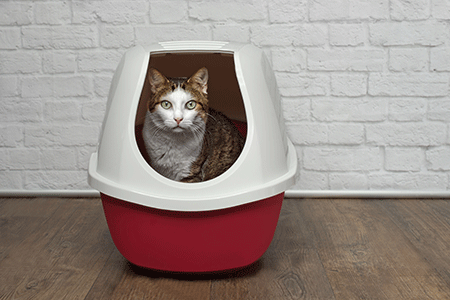Nutrient strategies for managing those (FIC)kle FLUTD cases
Most feline lower urinary tract disease is idiopathic, and while there may not be a cure, there are plenty of nutritional tweaks we can make to help manage the condition.
Lightspruch/stock.adobe.com

Feline lower urinary tract disease (FLUTD) describes any condition affecting the urinary bladder or urethra of cats and is a common reason for hospital visits. As knowledge about the specific causes of FLUTD has grown over the past decade, diagnostic and therapeutic efforts are now able to be directed toward identifying and eliminating particular underlying disorders.
The most common cause of FLUTD in cats less than 10 years of age is feline idiopathic cystitis (FIC), followed by uroliths and then urethral plugs. A diagnosis of FIC is made by excluding all other causes of FLUTD. In cats older than 10, the most common causes of FLUTD are urinary tract infections and uroliths.1,2
Diagnostics
Diagnostic evaluation of cats with recurrent or persistent lower urinary tract signs should include a urinalysis and diagnostic imaging. If the patient has a history of urinary tract manipulation (e.g. urethral catheterization), evidence of a urinary tract infection (e.g. pyuria, bacteriuria, malodorous urine), or the cat is older (usually > 10 years), a urine culture is also recommended.3
Survey radiographs help in identifying radiopaque uroliths and crystalline-matrix urethral plugs. Be sure to position the patient to include the caudal abdomen (urethra) in the radiograph. If not, you risk missing potentially important information. Even if the radiographs appear normal, FIC, radiolucent uroliths (urate/purine), small uroliths (< 2 mm), neoplasia, blood clots or anatomic defects may still be present. Abdominal ultrasonography and contrast urethrocystography are helpful in these cases. If no cause is identified after thorough diagnostic evaluation, a diagnosis of FIC is very likely.
Nutritional management of FIC
The two goals of managing cats with FIC are to decrease the severity of clinical signs and increase the interval between episodes of lower urinary tract disease. The following nutritional strategies can help.
Moisture. Feeding moist food (> 60% moisture) has been associated with a decreased recurrence of clinical signs in cats with FIC.4 During a one-year study, clinical signs recurred less often in FIC cats fed a moist food compared with cats fed the dry formulation of the same food.4 Relatedly, beneficial effects have also been observed in cats with FIC when urine specific gravity values decrease from 1.050 to values between 1.032 and 1.041,4 so you should discuss methods for increasing water intake (e.g. adding broth to foods, placing ice cubes in the cat's water, providing water fountains) with your clients.
Therapeutic diets. More recently, a 2013 study found that consistently feeding a therapeutic food for urinary conditions is associated with a reduction in recurrent episodes of FIC signs.5 This research was the first to definitively show that foods with different nutritional profiles impact the expression of acute episodes of FIC signs in cats.
Amino acids. L-tryptophan, a precursor of serotonin that inhibits neurotransmitters in the brain to balance mood, and hydrolyzed casein, a bioactive peptide that helps relieve anxiety in cats, have been identified as nutrients that can aid in managing the stress component of FIC.6,7
Fatty acids. Inflammation plays a role in many causes of FLUTD, especially FIC and urolithiasis, which is why omega-3 fatty acids (and their anti-inflammatory effects) are key in managing cats with FLUTD. In addition, vitamin E and beta-carotene are helpful for counteracting oxidative stress and reducing free radical damage-conditions that often accompany inflammation.
Pour forth knowledge
One of the most impactful ways you can use this nutrition information to help your patients is to pass it along to your clients. If you're able to help them understand how nutrients play a role in managing FLUTD caused by FIC, they're much more likely to be compliant with the veterinarian's recommendations, and that's good for everyone involved-especially the patient.
References
- Burns KM. FLUTD – Using nutrition to go with the flow. NAVTA Journal, Convention Edition 2014;7-12.
- Grauer G. Current thoughts on pathophysiology & treatment of feline idiopathic cystitis. Today's Vet Pract 2013;Nov/Dec:38-41.
- Lulich JP. FLUTD: Are you missing the correct diagnosis?, in Proceedings. Hill's FLUTD Symposium 2007;12-19.
- Markwell PJ, Buffington CA, Chew DJ, et al. Clinical evaluation of commercially available urinary acidification diets in the management of idiopathic cystitis in cats. J Am Vet Med Assoc 1999;214(3):361-365.
- Kruger JM, Lulich JP, Merrills J, et al. A year-long prospective, randomized, double-masked study of nutrition on feline idiopathic Cystitis, in Proceedings. American College of Veterinary Internal Medicine Forum 2013.
- Pereira GG, Fragoso S, Pires E. Effect of dietary intake of l-tryptophan supplementation on multi-housed cats presenting stress related behaviors, in Proceedings. British Small Animal Veterinary Society 2010.
- Beata C, Beaumont-Graff E, Coll V, et al. Effect of alpha-casozepine (Zylkene) on anxiety in cats. J Vet Behav 2007;2(2):40-46.
Kara Burns is a licensed veterinary technician with masters' degrees in physiology and counseling psychology and is a VTS in nutrition. She is the founder and president of the Academy of Veterinary Nutrition Technicians and is the current president of NAVTA. Kara teaches nutrition courses around the world and is an independent nutritional consultant as well as a consultant for the Lafeber Company and Emeraid. In her spare time, she enjoys collecting sports memorabilia (especially hockey items) and is a storm spotter for the National Weather Service. A superhero enthusiast, Kara has a Persian kitty named Oliver Queen.